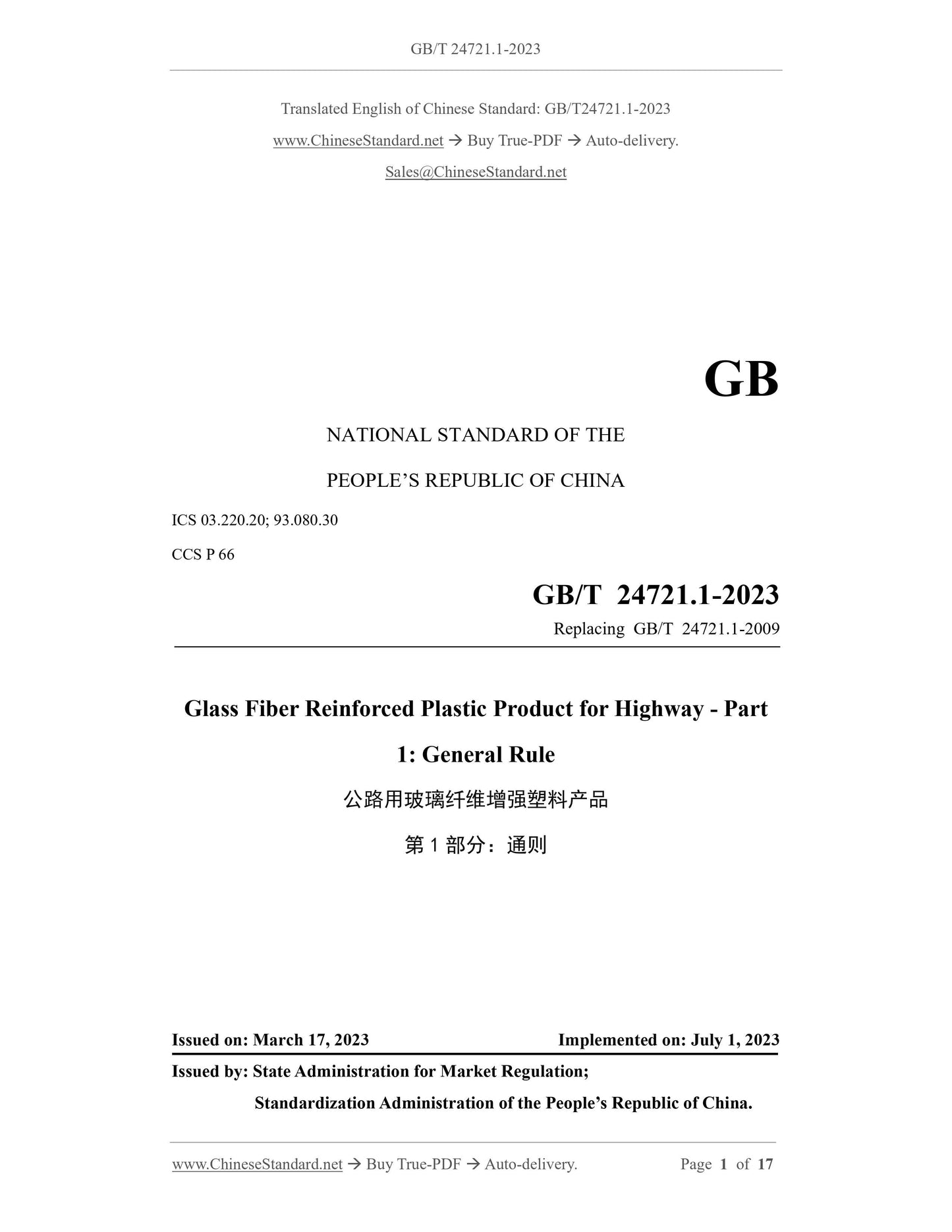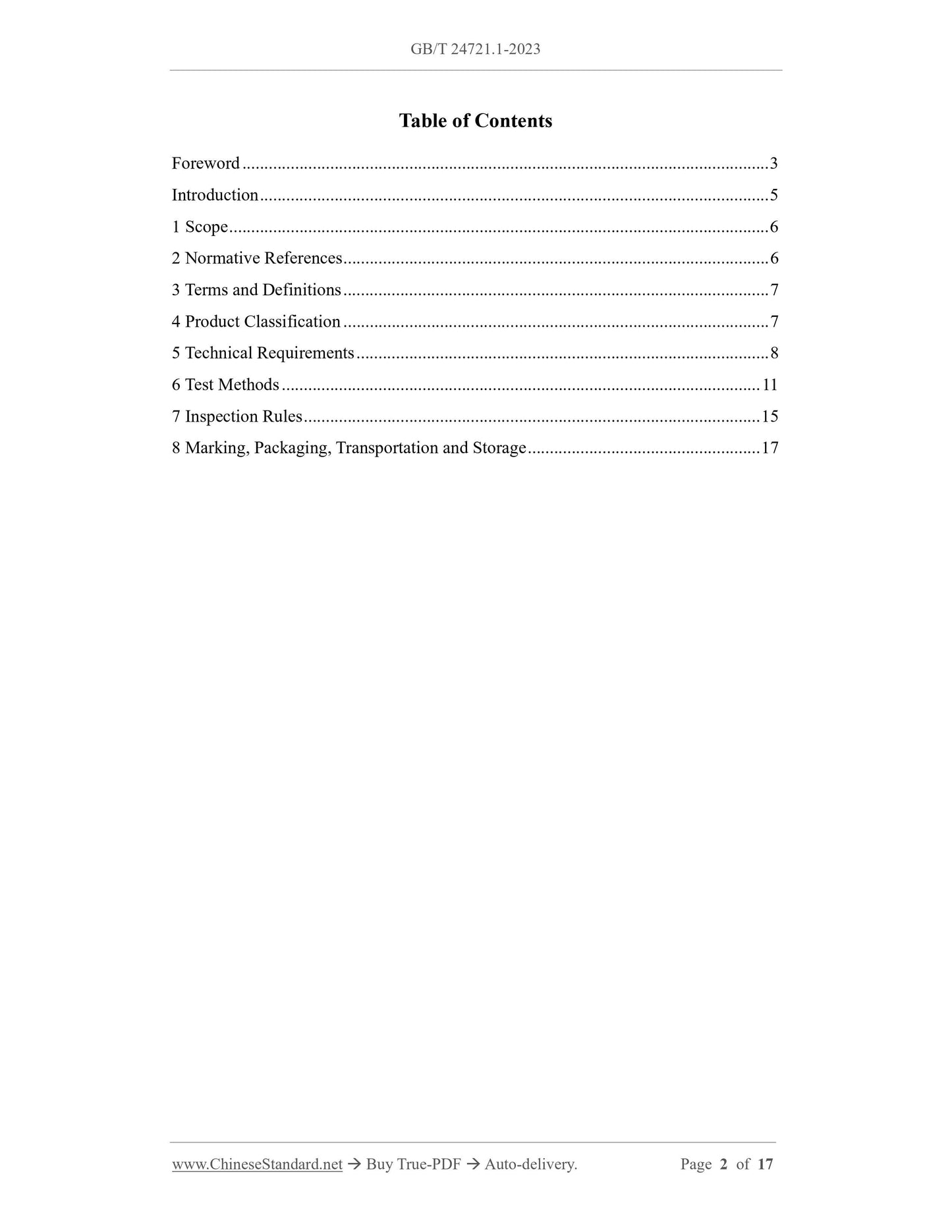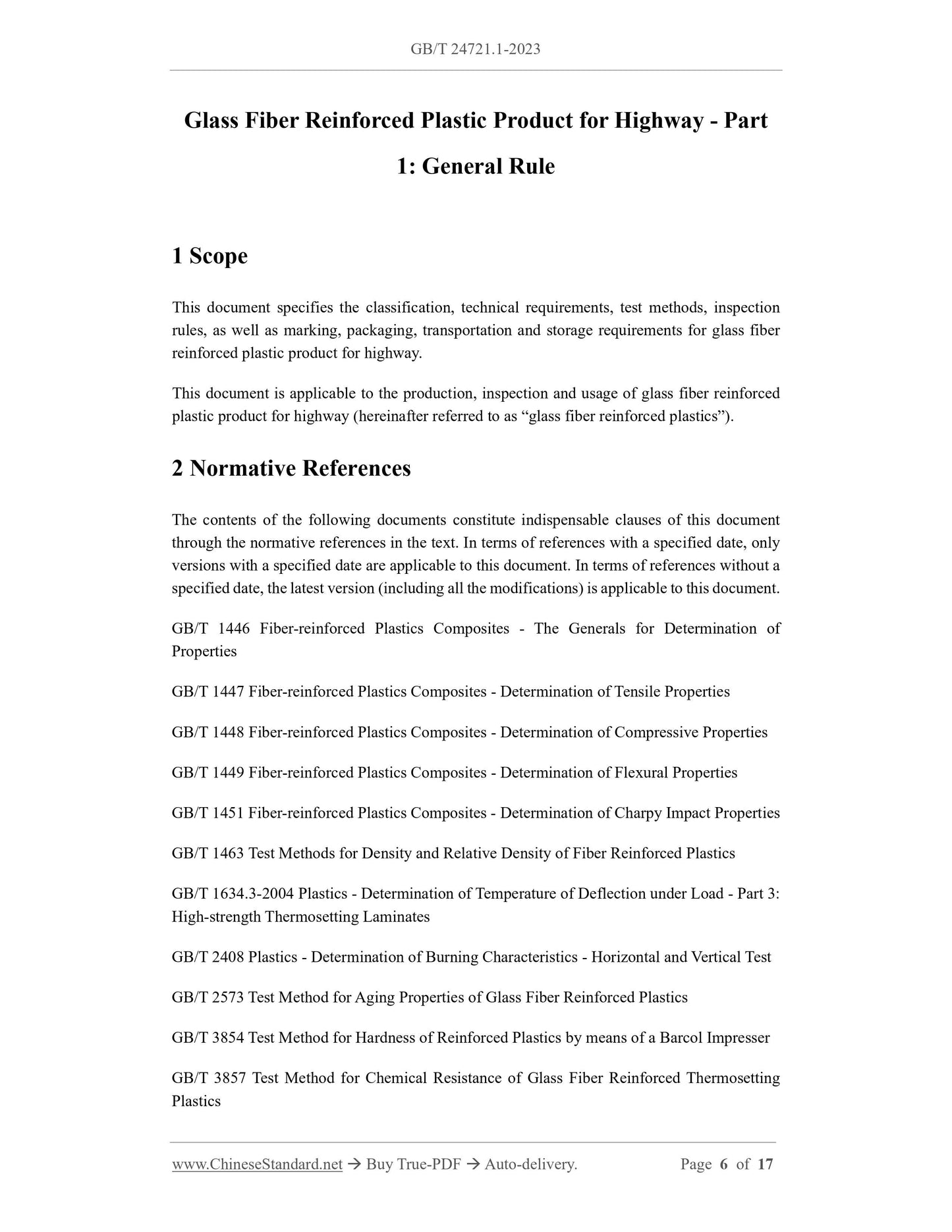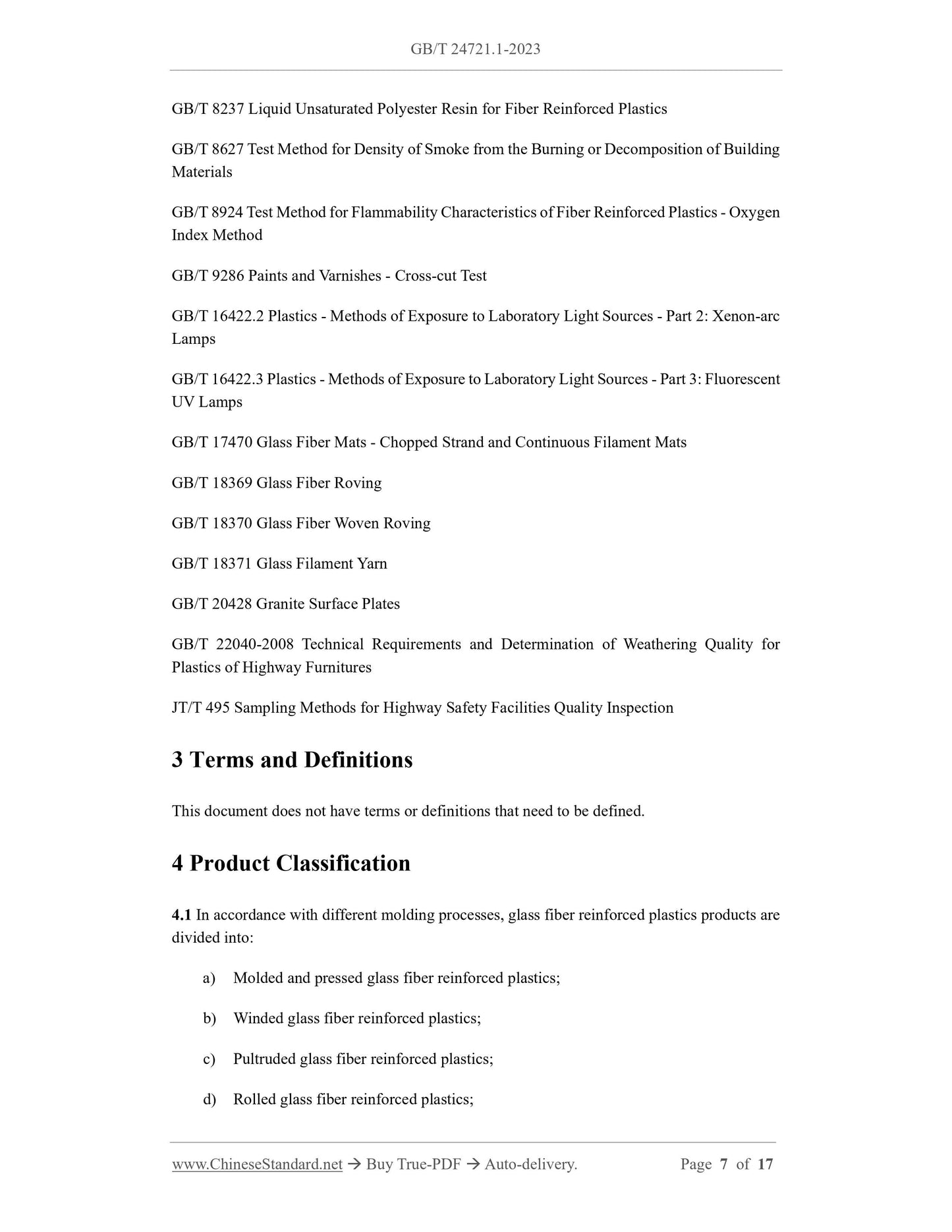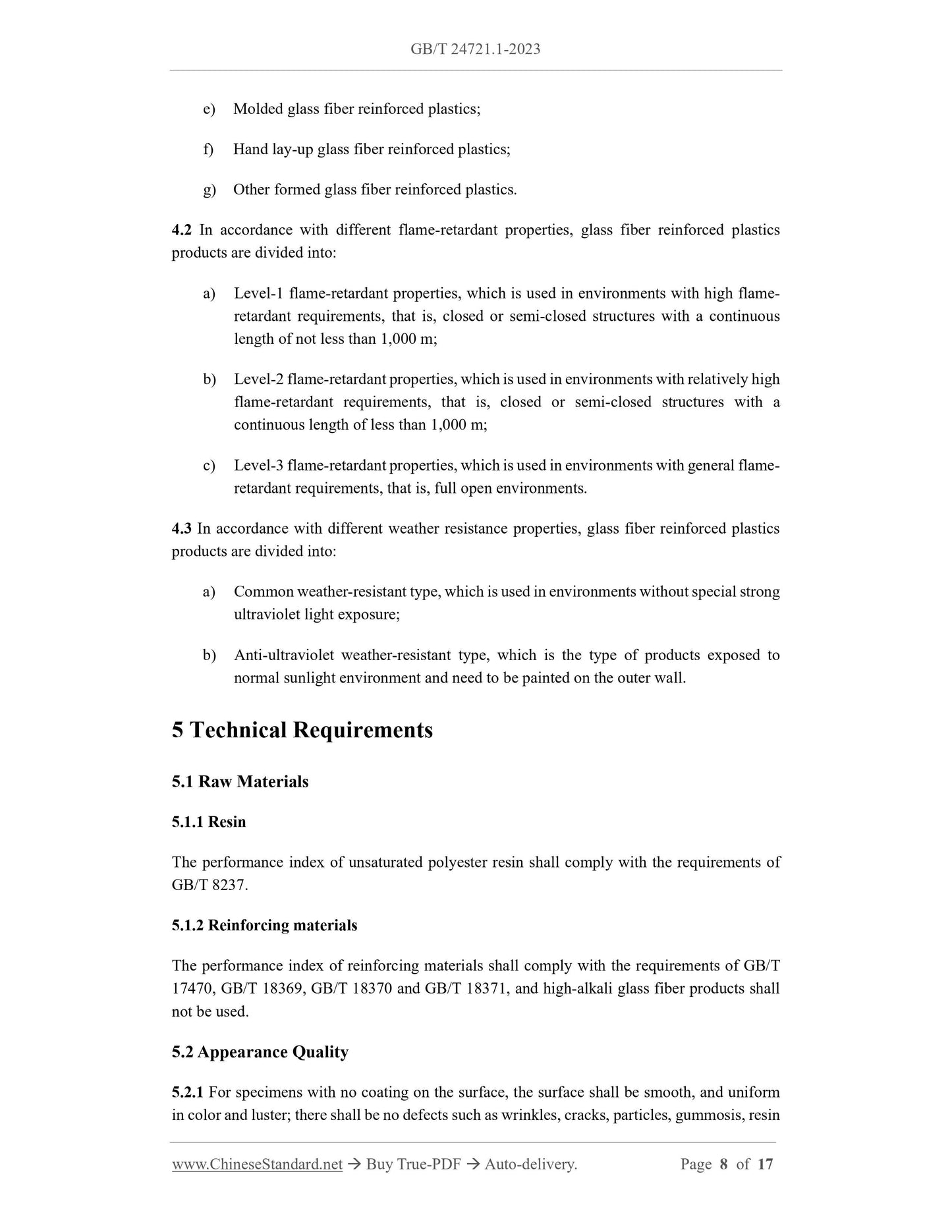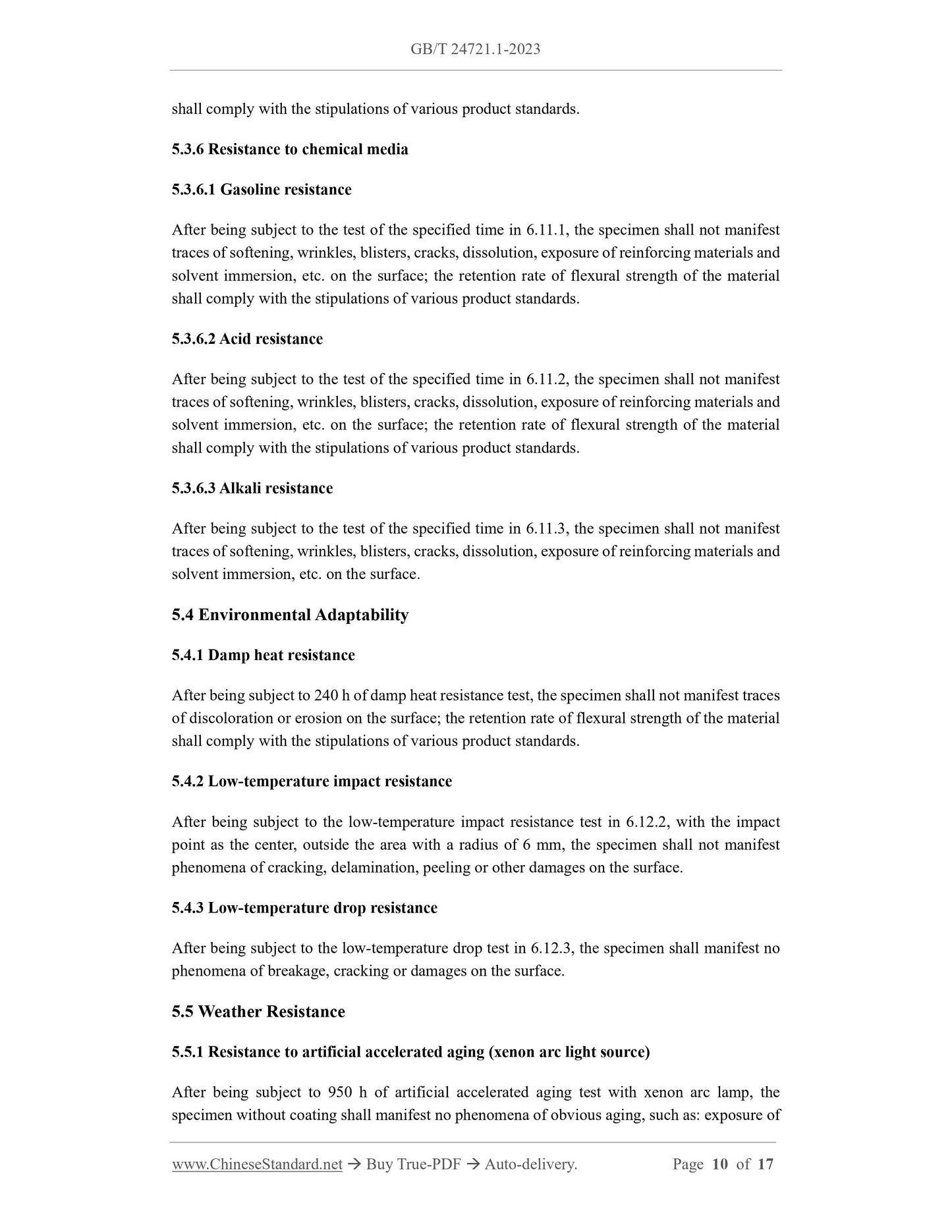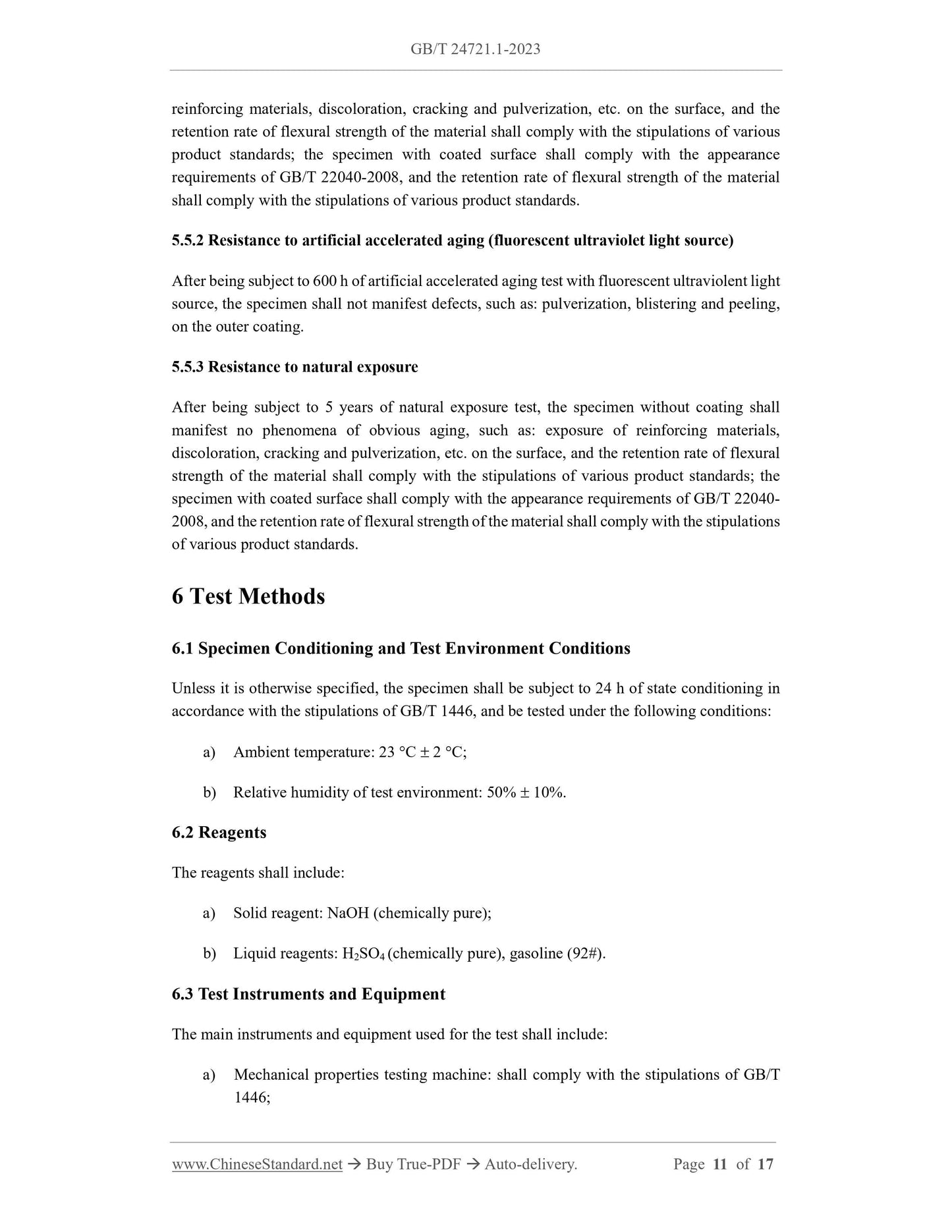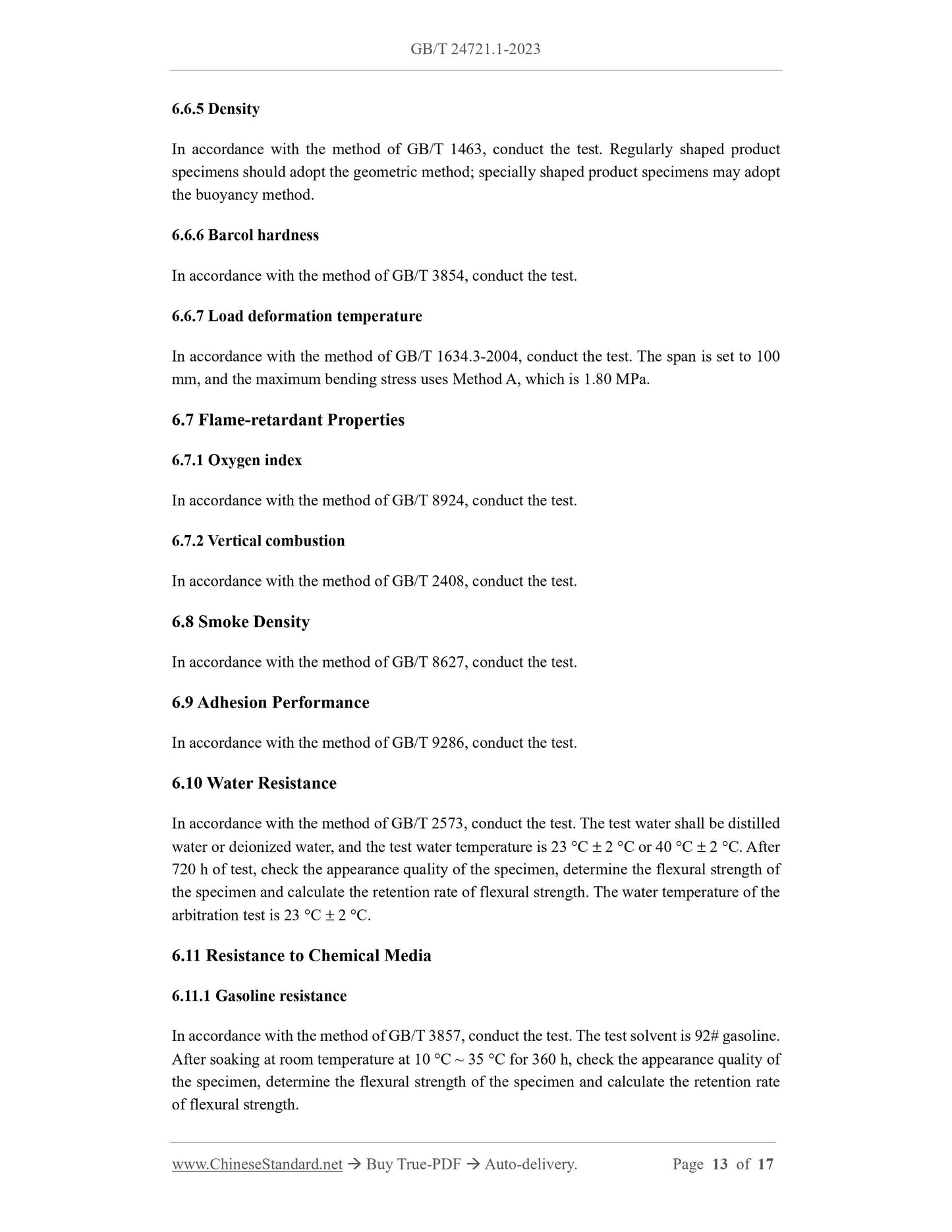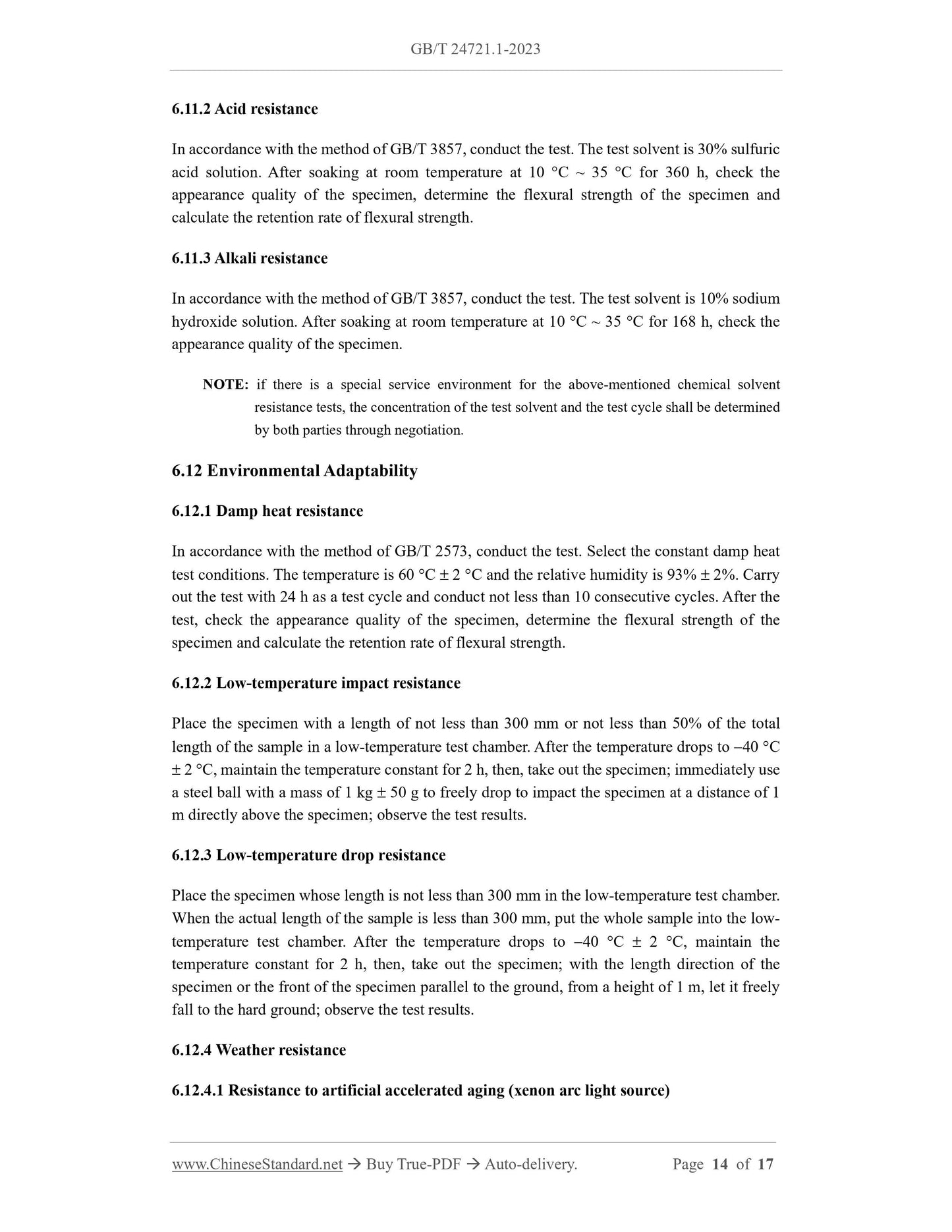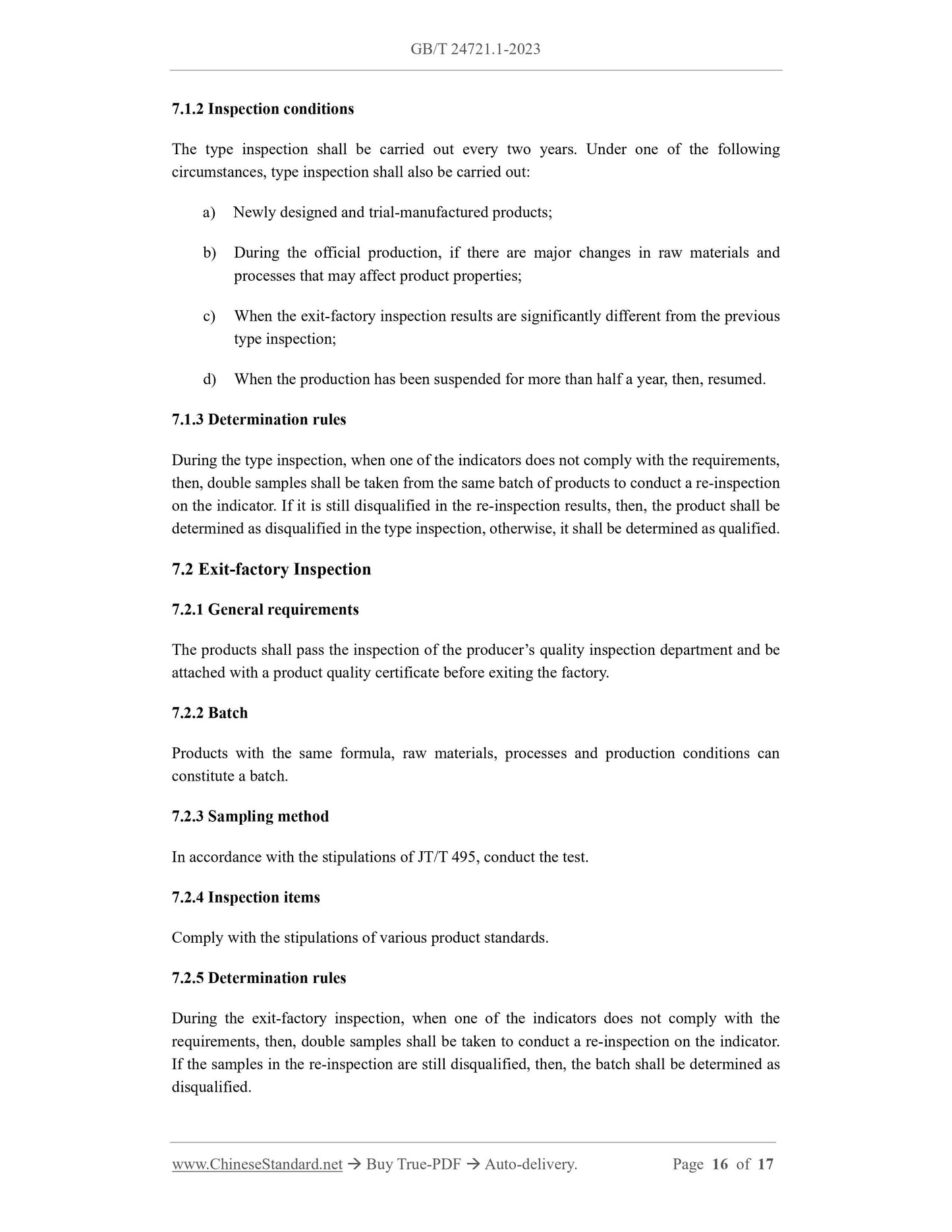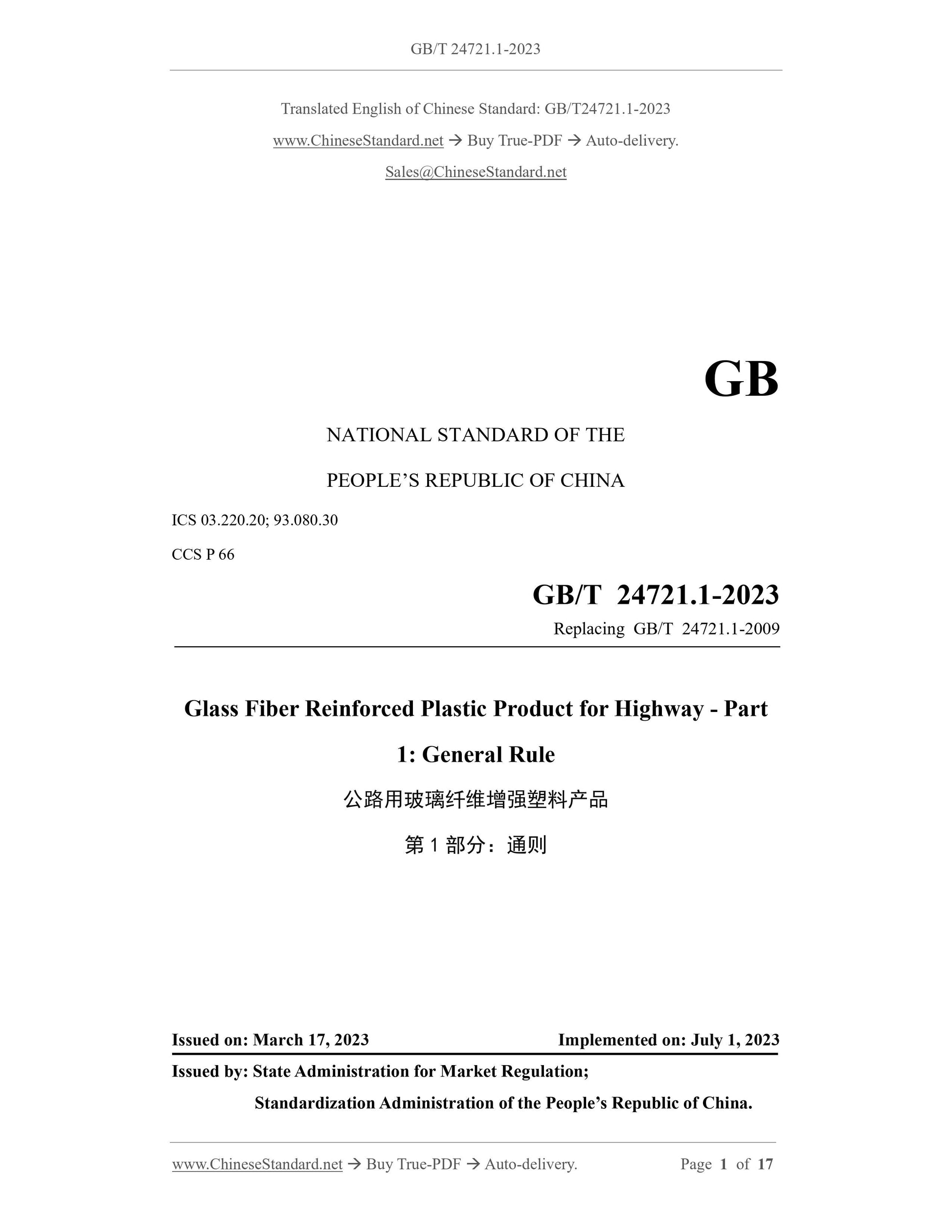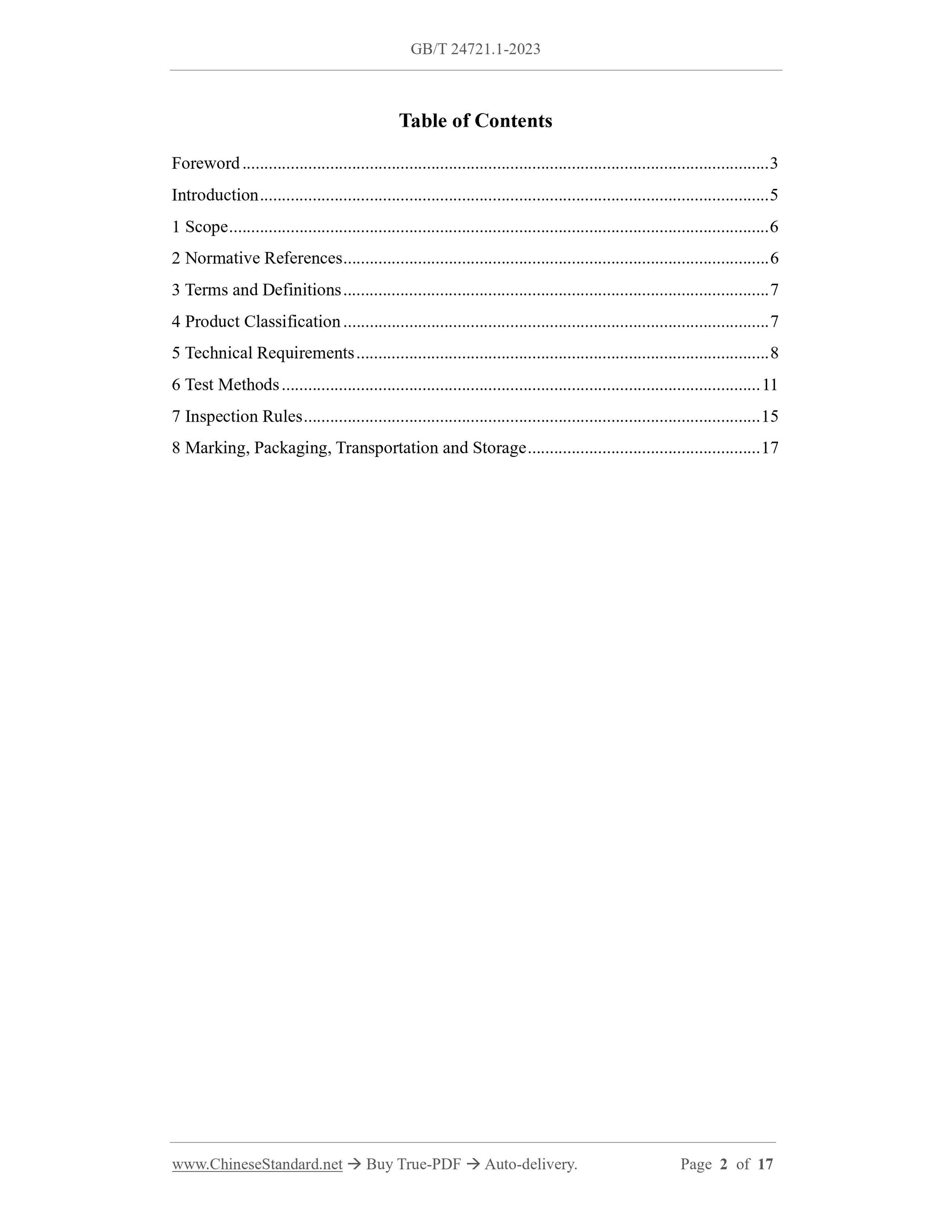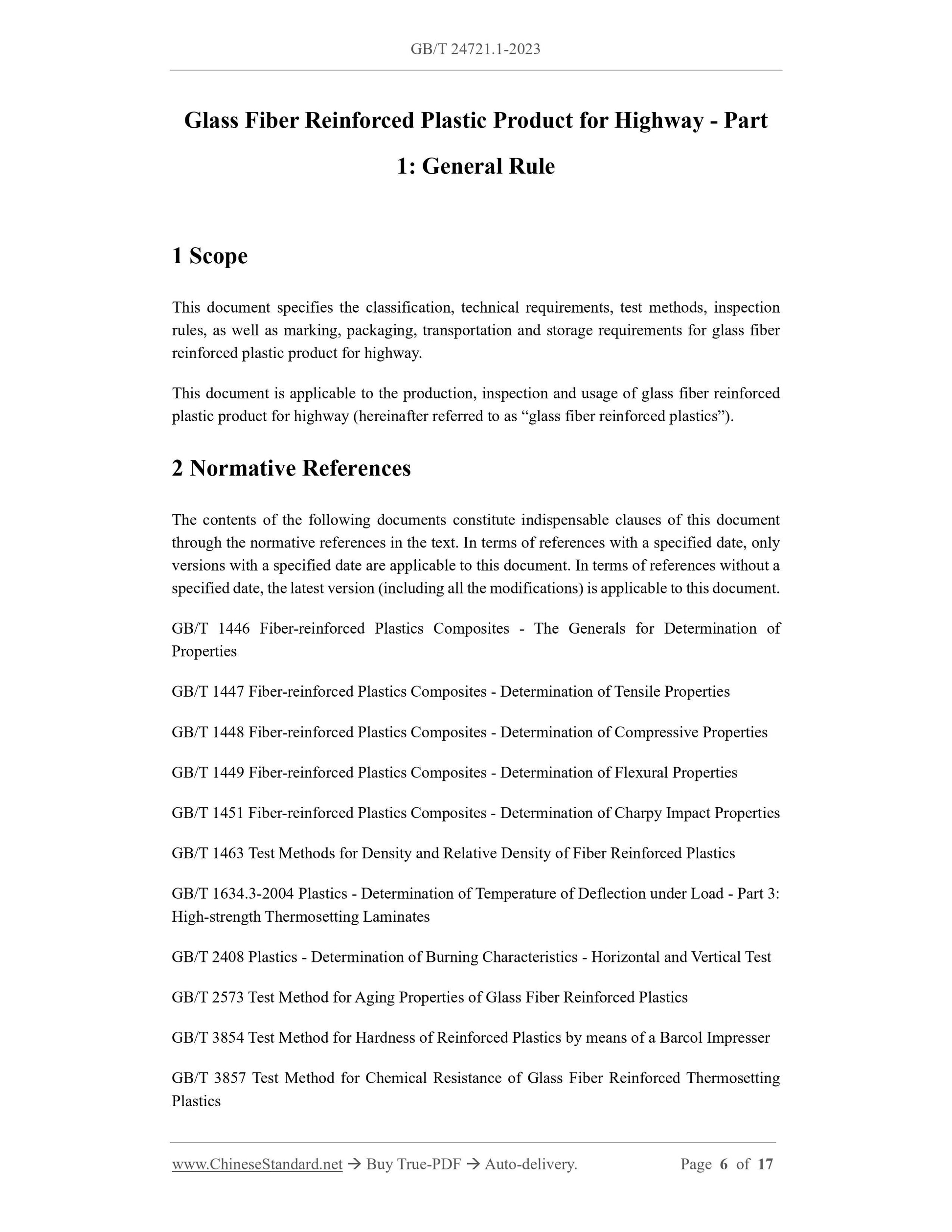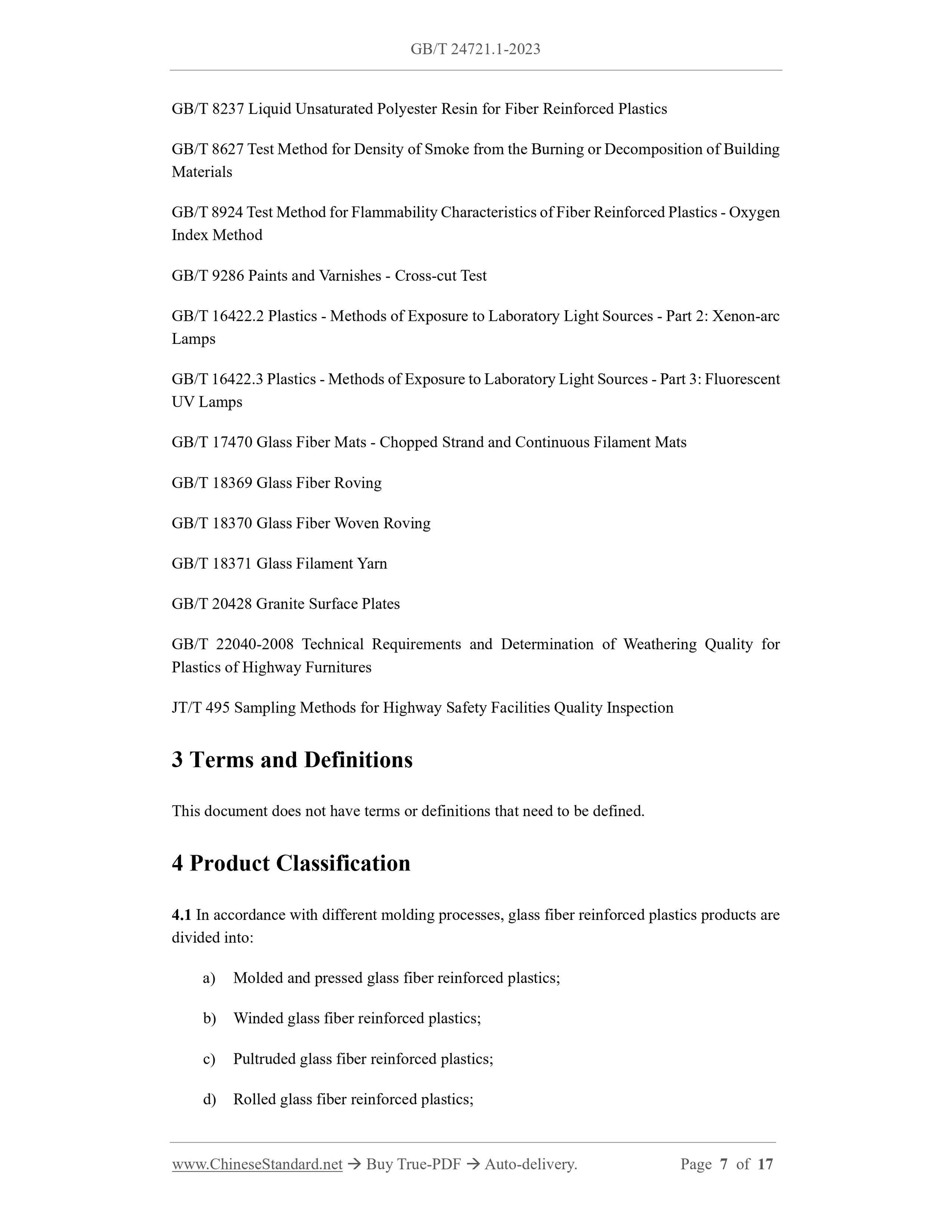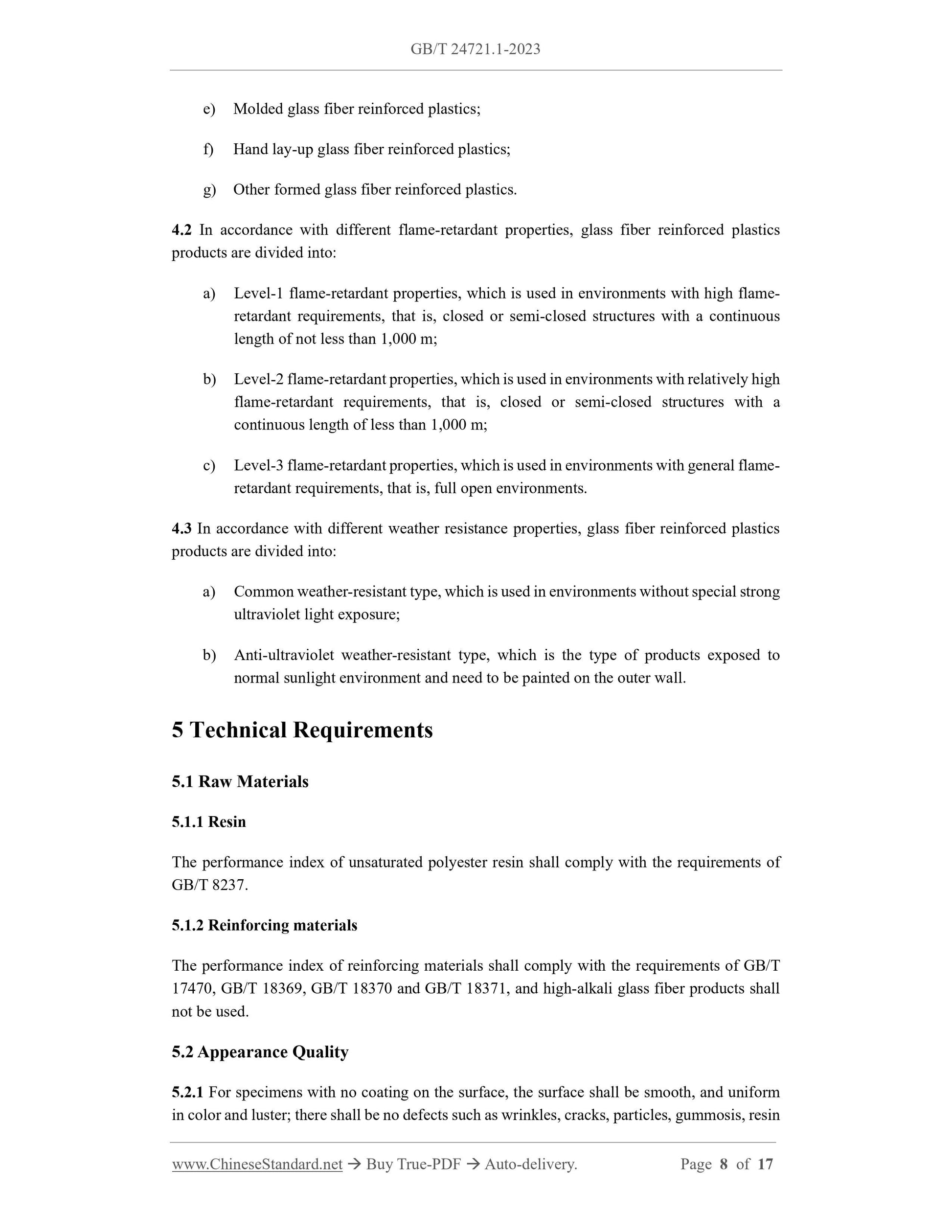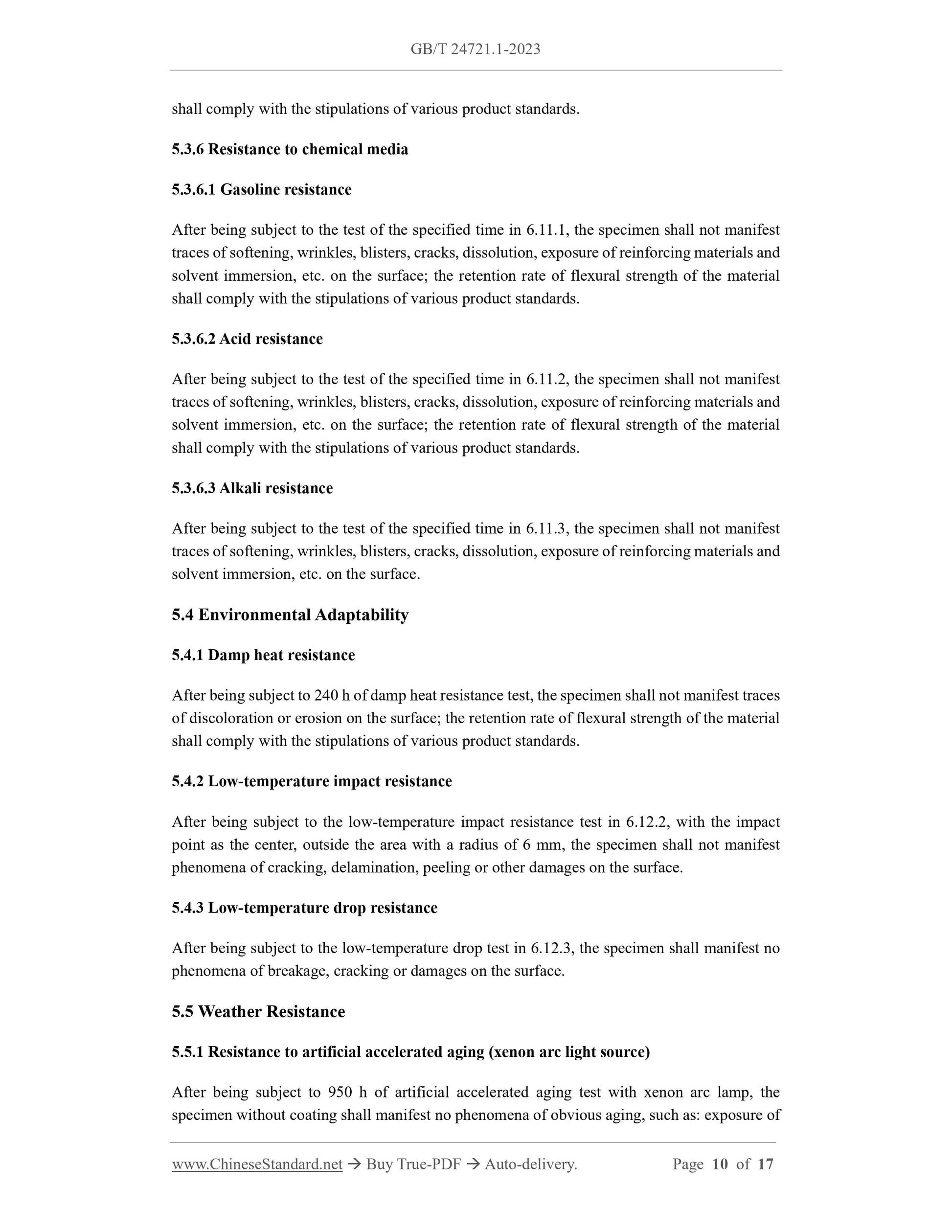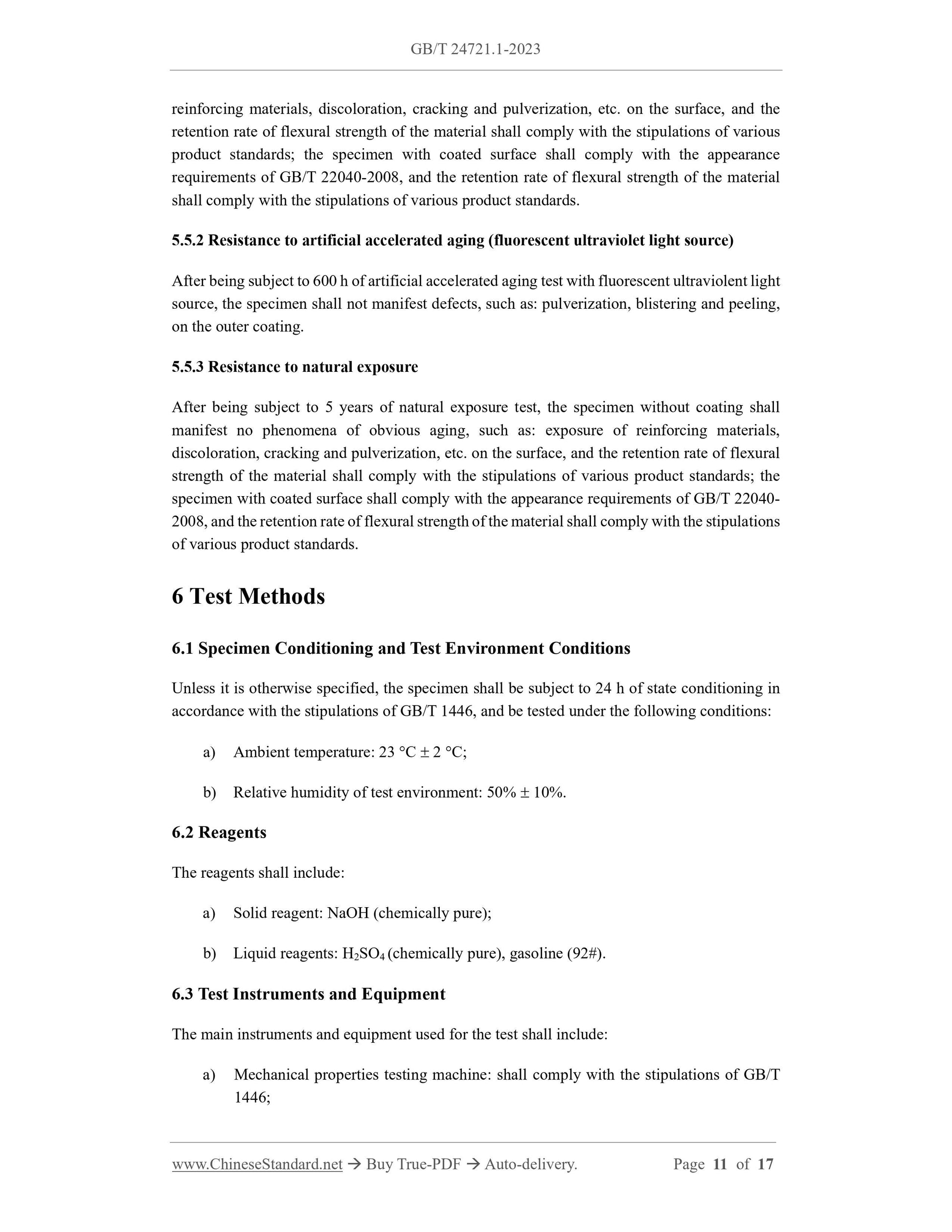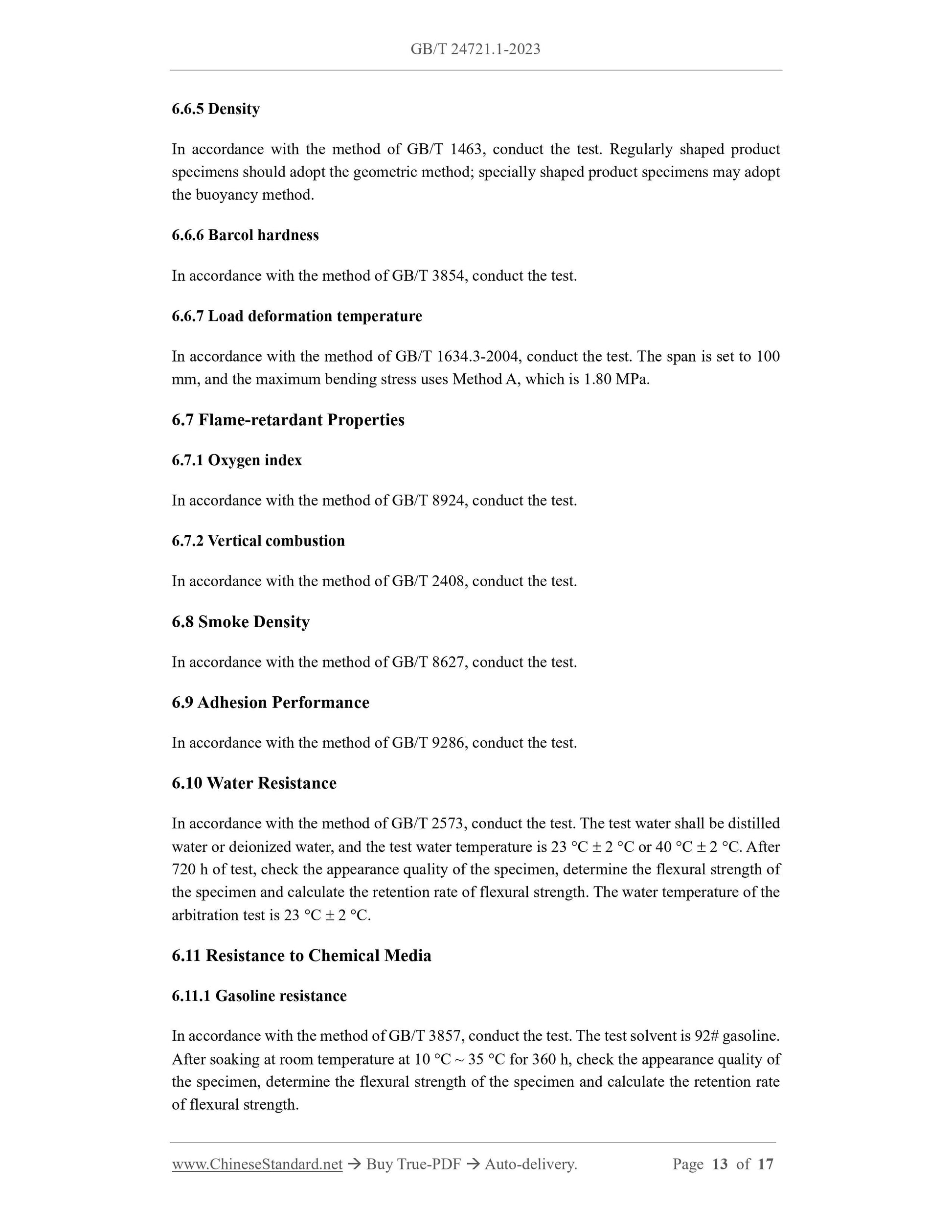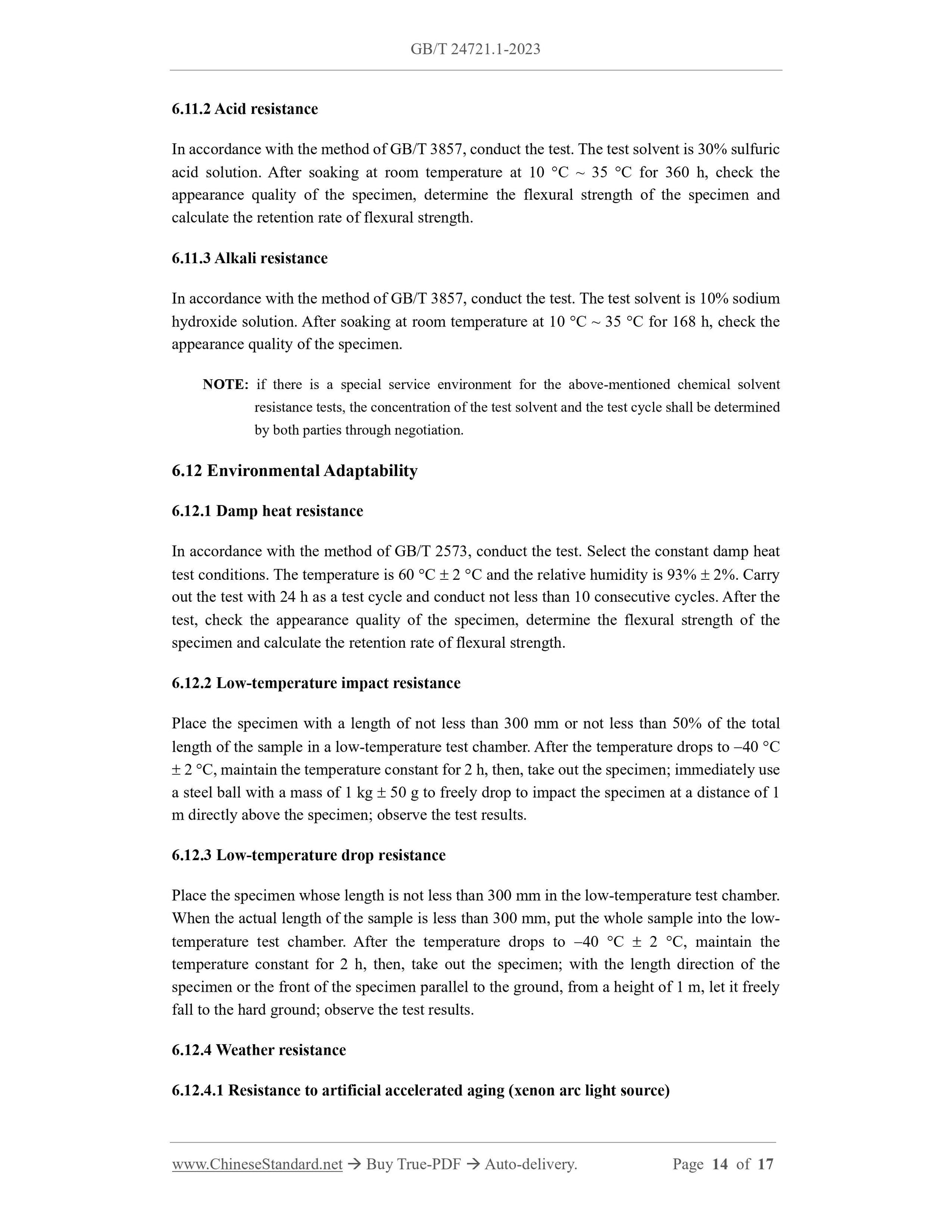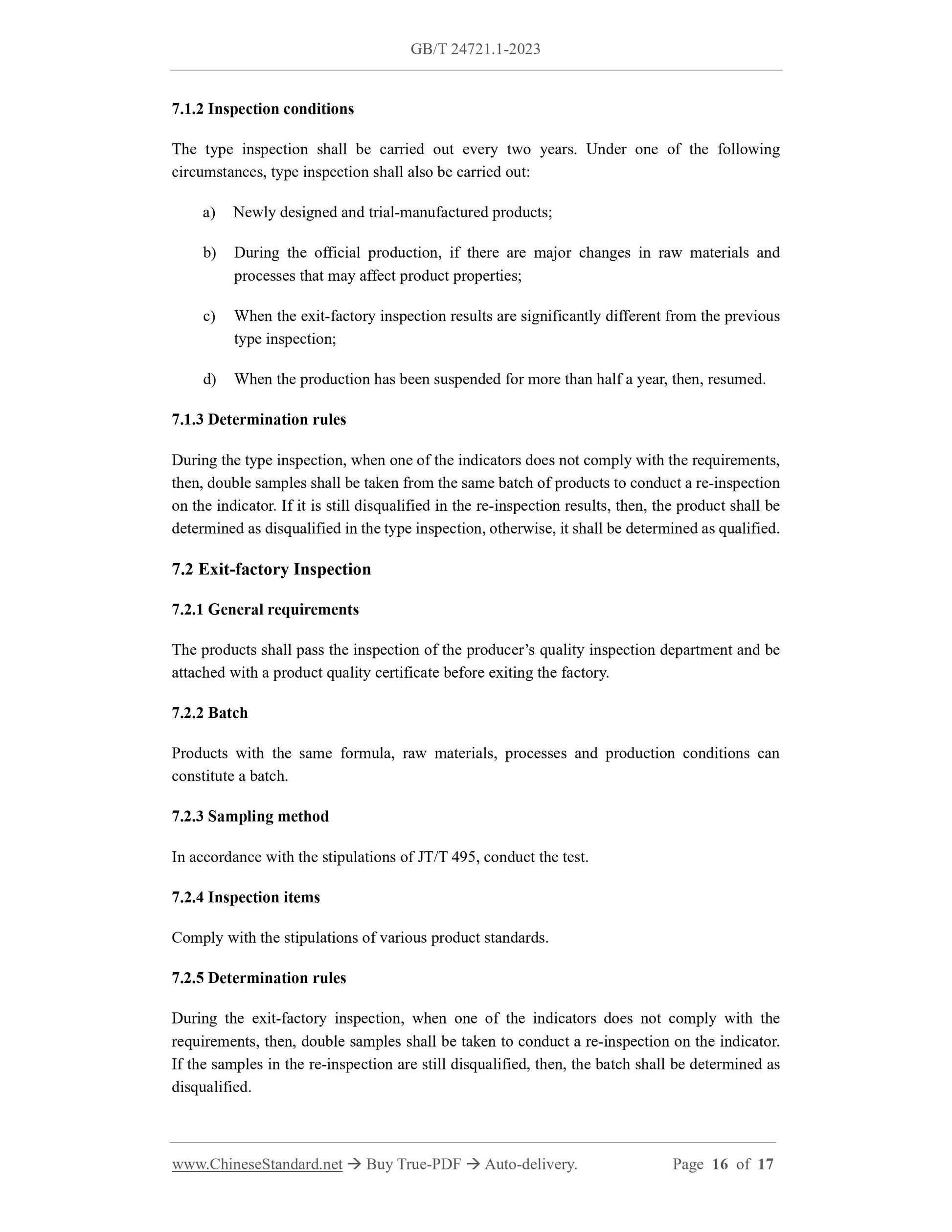1
/
of
10
PayPal, credit cards. Download editable-PDF & invoice In 1 second!
GB/T 24721.1-2023 English PDF (GBT24721.1-2023)
GB/T 24721.1-2023 English PDF (GBT24721.1-2023)
Regular price
$230.00 USD
Regular price
Sale price
$230.00 USD
Unit price
/
per
Shipping calculated at checkout.
Couldn't load pickup availability
Delivery: 3 seconds. Download true-PDF + Invoice.
Get QUOTATION in 1-minute: Click GB/T 24721.1-2023
Historical versions: GB/T 24721.1-2023
Preview True-PDF (Reload/Scroll if blank)
GB/T 24721.1-2023: Glass fiber reinforced plastic product for highway -- Part 1: General rule
GB/T 24721.1-2023
GB
NATIONAL STANDARD OF THE
PEOPLE’S REPUBLIC OF CHINA
ICS 03.220.20; 93.080.30
CCS P 66
Replacing GB/T 24721.1-2009
Glass Fiber Reinforced Plastic Product for Highway - Part
1: General Rule
ISSUED ON: MARCH 17, 2023
IMPLEMENTED ON: JULY 1, 2023
Issued by: State Administration for Market Regulation;
Standardization Administration of the People’s Republic of China.
Table of Contents
Foreword ... 3
Introduction ... 5
1 Scope ... 6
2 Normative References ... 6
3 Terms and Definitions ... 7
4 Product Classification ... 7
5 Technical Requirements ... 8
6 Test Methods ... 11
7 Inspection Rules ... 15
8 Marking, Packaging, Transportation and Storage ... 17
Glass Fiber Reinforced Plastic Product for Highway - Part
1: General Rule
1 Scope
This document specifies the classification, technical requirements, test methods, inspection
rules, as well as marking, packaging, transportation and storage requirements for glass fiber
reinforced plastic product for highway.
This document is applicable to the production, inspection and usage of glass fiber reinforced
plastic product for highway (hereinafter referred to as “glass fiber reinforced plastics”).
2 Normative References
The contents of the following documents constitute indispensable clauses of this document
through the normative references in the text. In terms of references with a specified date, only
versions with a specified date are applicable to this document. In terms of references without a
specified date, the latest version (including all the modifications) is applicable to this document.
GB/T 1446 Fiber-reinforced Plastics Composites - The Generals for Determination of
Properties
GB/T 1447 Fiber-reinforced Plastics Composites - Determination of Tensile Properties
GB/T 1448 Fiber-reinforced Plastics Composites - Determination of Compressive Properties
GB/T 1449 Fiber-reinforced Plastics Composites - Determination of Flexural Properties
GB/T 1451 Fiber-reinforced Plastics Composites - Determination of Charpy Impact Properties
GB/T 1463 Test Methods for Density and Relative Density of Fiber Reinforced Plastics
GB/T 1634.3-2004 Plastics - Determination of Temperature of Deflection under Load - Part 3:
High-strength Thermosetting Laminates
GB/T 2408 Plastics - Determination of Burning Characteristics - Horizontal and Vertical Test
GB/T 2573 Test Method for Aging Properties of Glass Fiber Reinforced Plastics
GB/T 3854 Test Method for Hardness of Reinforced Plastics by means of a Barcol Impresser
GB/T 3857 Test Method for Chemical Resistance of Glass Fiber Reinforced Thermosetting
Plastics
GB/T 8237 Liquid Unsaturated Polyester Resin for Fiber Reinforced Plastics
GB/T 8627 Test Method for Density of Smoke from the Burning or Decomposition of Building
Materials
GB/T 8924 Test Method for Flammability Characteristics of Fiber Reinforced Plastics - Oxygen
Index Method
GB/T 9286 Paints and Varnishes - Cross-cut Test
GB/T 16422.2 Plastics - Methods of Exposure to Laboratory Light Sources - Part 2: Xenon-arc
Lamps
GB/T 16422.3 Plastics - Methods of Exposure to Laboratory Light Sources - Part 3: Fluorescent
UV Lamps
GB/T 17470 Glass Fiber Mats - Chopped Strand and Continuous Filament Mats
GB/T 18369 Glass Fiber Roving
GB/T 18370 Glass Fiber Woven Roving
GB/T 18371 Glass Filament Yarn
GB/T 20428 Granite Surface Plates
GB/T 22040-2008 Technical Requirements and Determination of Weathering Quality for
Plastics of Highway Furnitures
JT/T 495 Sampling Methods for Highway Safety Facilities Quality Inspection
3 Terms and Definitions
This document does not have terms or definitions that need to be defined.
4 Product Classification
4.1 In accordance with different molding processes, glass fiber reinforced plastics products are
divided into:
a) Molded and pressed glass fiber reinforced plastics;
b) Winded glass fiber reinforced plastics;
c) Pultruded glass fiber reinforced plastics;
d) Rolled glass fiber reinforced plastics;
e) Molded glass fiber reinforced plastics;
f) Hand lay-up glass fiber reinforced plastics;
g) Other formed glass fiber reinforced plastics.
4.2 In accordance with different flame-retardant properties, glass fiber reinforced plastics
products are divided into:
a) Level-1 flame-retardant properties, which is used in environments with high flame-
retardant requirements, that is, closed or semi-closed structures with a continuous
length of not less than 1,000 m;
b) Level-2 flame-retardant properties, which is used in environments with relatively high
flame-retardant requirements, that is, closed or semi-closed structures with a
continuous length of less than 1,000 m;
c) Level-3 flame-retardant properties, which is used in environments with general flame-
retardant requirements, that is, full open environments.
4.3 In accordance with different weather resistance properties, glass fiber reinforced plastics
products are divided into:
a) Common weather-resistant type, which is used in environments without special strong
ultraviolet light exposure;
b) Anti-ultraviolet weather-resistant type, which is the type of products exposed to
normal sunlight environment and need to be painted on the outer wall.
5 Technical Requirements
5.1 Raw Materials
5.1.1 Resin
The performance index of unsaturated polyester resin shall comply with the requirements of
GB/T 8237.
5.1.2 Reinforcing materials
The performance index of reinforcing materials shall comply with the requirements of GB/T
17470, GB/T 18369, GB/T 18370 and GB/T 18371, and high-alkali glass fiber products shall
not be used.
5.2 Appearance Quality
5.2.1 For specimens with no coating on the surface, the surface shall be smooth, and uniform
in color and luster; there shall be no defects such as wrinkles, cracks, particles, gummosis, resin
shall comply with the stipulations of various product standards.
5.3.6 Resistance to chemical media
5.3.6.1 Gasoline resistance
After being subject to the test of the specified time in 6.11.1, the specimen shall not manifest
traces of softening, wrinkles, blisters, cracks, dissolution, exposure of reinforcing materials and
solvent immersion, etc. on the surface; the retention rate of flexural strength of the material
shall comply with the stipulations of various product standards.
5.3.6.2 Acid resistance
After being subject to the test of the specified time in 6.11.2, the specimen shall not manifest
traces of softening, wrinkles, blisters, cracks, dissolution, exposure of reinforcing materials and
solvent immersion, etc. on the surface; the retention rate of flexural strength of the material
shall comply with the stipulations of various product standards.
5.3.6.3 Alkali resistance
After being subject to the test of the specified time in 6.11.3, the specimen shall not manifest
traces of softening, wrinkles, blisters, cracks, dissolution, exposure of reinforcing materials and
solvent immersion, etc. on the surface.
5.4 Environmental Adaptability
5.4.1 Damp heat resistance
After being subject to 240 h of damp heat resistance test, the specimen shall not manifest traces
of discoloration or erosion on the surface; the retention rate of flexural strength of the material
shall comply with the stipulations of various product standards.
5.4.2 Low-temperature impact resistance
After being subject to the low-temperature impact resistance test in 6.12.2, with the impact
point as the ...
Get QUOTATION in 1-minute: Click GB/T 24721.1-2023
Historical versions: GB/T 24721.1-2023
Preview True-PDF (Reload/Scroll if blank)
GB/T 24721.1-2023: Glass fiber reinforced plastic product for highway -- Part 1: General rule
GB/T 24721.1-2023
GB
NATIONAL STANDARD OF THE
PEOPLE’S REPUBLIC OF CHINA
ICS 03.220.20; 93.080.30
CCS P 66
Replacing GB/T 24721.1-2009
Glass Fiber Reinforced Plastic Product for Highway - Part
1: General Rule
ISSUED ON: MARCH 17, 2023
IMPLEMENTED ON: JULY 1, 2023
Issued by: State Administration for Market Regulation;
Standardization Administration of the People’s Republic of China.
Table of Contents
Foreword ... 3
Introduction ... 5
1 Scope ... 6
2 Normative References ... 6
3 Terms and Definitions ... 7
4 Product Classification ... 7
5 Technical Requirements ... 8
6 Test Methods ... 11
7 Inspection Rules ... 15
8 Marking, Packaging, Transportation and Storage ... 17
Glass Fiber Reinforced Plastic Product for Highway - Part
1: General Rule
1 Scope
This document specifies the classification, technical requirements, test methods, inspection
rules, as well as marking, packaging, transportation and storage requirements for glass fiber
reinforced plastic product for highway.
This document is applicable to the production, inspection and usage of glass fiber reinforced
plastic product for highway (hereinafter referred to as “glass fiber reinforced plastics”).
2 Normative References
The contents of the following documents constitute indispensable clauses of this document
through the normative references in the text. In terms of references with a specified date, only
versions with a specified date are applicable to this document. In terms of references without a
specified date, the latest version (including all the modifications) is applicable to this document.
GB/T 1446 Fiber-reinforced Plastics Composites - The Generals for Determination of
Properties
GB/T 1447 Fiber-reinforced Plastics Composites - Determination of Tensile Properties
GB/T 1448 Fiber-reinforced Plastics Composites - Determination of Compressive Properties
GB/T 1449 Fiber-reinforced Plastics Composites - Determination of Flexural Properties
GB/T 1451 Fiber-reinforced Plastics Composites - Determination of Charpy Impact Properties
GB/T 1463 Test Methods for Density and Relative Density of Fiber Reinforced Plastics
GB/T 1634.3-2004 Plastics - Determination of Temperature of Deflection under Load - Part 3:
High-strength Thermosetting Laminates
GB/T 2408 Plastics - Determination of Burning Characteristics - Horizontal and Vertical Test
GB/T 2573 Test Method for Aging Properties of Glass Fiber Reinforced Plastics
GB/T 3854 Test Method for Hardness of Reinforced Plastics by means of a Barcol Impresser
GB/T 3857 Test Method for Chemical Resistance of Glass Fiber Reinforced Thermosetting
Plastics
GB/T 8237 Liquid Unsaturated Polyester Resin for Fiber Reinforced Plastics
GB/T 8627 Test Method for Density of Smoke from the Burning or Decomposition of Building
Materials
GB/T 8924 Test Method for Flammability Characteristics of Fiber Reinforced Plastics - Oxygen
Index Method
GB/T 9286 Paints and Varnishes - Cross-cut Test
GB/T 16422.2 Plastics - Methods of Exposure to Laboratory Light Sources - Part 2: Xenon-arc
Lamps
GB/T 16422.3 Plastics - Methods of Exposure to Laboratory Light Sources - Part 3: Fluorescent
UV Lamps
GB/T 17470 Glass Fiber Mats - Chopped Strand and Continuous Filament Mats
GB/T 18369 Glass Fiber Roving
GB/T 18370 Glass Fiber Woven Roving
GB/T 18371 Glass Filament Yarn
GB/T 20428 Granite Surface Plates
GB/T 22040-2008 Technical Requirements and Determination of Weathering Quality for
Plastics of Highway Furnitures
JT/T 495 Sampling Methods for Highway Safety Facilities Quality Inspection
3 Terms and Definitions
This document does not have terms or definitions that need to be defined.
4 Product Classification
4.1 In accordance with different molding processes, glass fiber reinforced plastics products are
divided into:
a) Molded and pressed glass fiber reinforced plastics;
b) Winded glass fiber reinforced plastics;
c) Pultruded glass fiber reinforced plastics;
d) Rolled glass fiber reinforced plastics;
e) Molded glass fiber reinforced plastics;
f) Hand lay-up glass fiber reinforced plastics;
g) Other formed glass fiber reinforced plastics.
4.2 In accordance with different flame-retardant properties, glass fiber reinforced plastics
products are divided into:
a) Level-1 flame-retardant properties, which is used in environments with high flame-
retardant requirements, that is, closed or semi-closed structures with a continuous
length of not less than 1,000 m;
b) Level-2 flame-retardant properties, which is used in environments with relatively high
flame-retardant requirements, that is, closed or semi-closed structures with a
continuous length of less than 1,000 m;
c) Level-3 flame-retardant properties, which is used in environments with general flame-
retardant requirements, that is, full open environments.
4.3 In accordance with different weather resistance properties, glass fiber reinforced plastics
products are divided into:
a) Common weather-resistant type, which is used in environments without special strong
ultraviolet light exposure;
b) Anti-ultraviolet weather-resistant type, which is the type of products exposed to
normal sunlight environment and need to be painted on the outer wall.
5 Technical Requirements
5.1 Raw Materials
5.1.1 Resin
The performance index of unsaturated polyester resin shall comply with the requirements of
GB/T 8237.
5.1.2 Reinforcing materials
The performance index of reinforcing materials shall comply with the requirements of GB/T
17470, GB/T 18369, GB/T 18370 and GB/T 18371, and high-alkali glass fiber products shall
not be used.
5.2 Appearance Quality
5.2.1 For specimens with no coating on the surface, the surface shall be smooth, and uniform
in color and luster; there shall be no defects such as wrinkles, cracks, particles, gummosis, resin
shall comply with the stipulations of various product standards.
5.3.6 Resistance to chemical media
5.3.6.1 Gasoline resistance
After being subject to the test of the specified time in 6.11.1, the specimen shall not manifest
traces of softening, wrinkles, blisters, cracks, dissolution, exposure of reinforcing materials and
solvent immersion, etc. on the surface; the retention rate of flexural strength of the material
shall comply with the stipulations of various product standards.
5.3.6.2 Acid resistance
After being subject to the test of the specified time in 6.11.2, the specimen shall not manifest
traces of softening, wrinkles, blisters, cracks, dissolution, exposure of reinforcing materials and
solvent immersion, etc. on the surface; the retention rate of flexural strength of the material
shall comply with the stipulations of various product standards.
5.3.6.3 Alkali resistance
After being subject to the test of the specified time in 6.11.3, the specimen shall not manifest
traces of softening, wrinkles, blisters, cracks, dissolution, exposure of reinforcing materials and
solvent immersion, etc. on the surface.
5.4 Environmental Adaptability
5.4.1 Damp heat resistance
After being subject to 240 h of damp heat resistance test, the specimen shall not manifest traces
of discoloration or erosion on the surface; the retention rate of flexural strength of the material
shall comply with the stipulations of various product standards.
5.4.2 Low-temperature impact resistance
After being subject to the low-temperature impact resistance test in 6.12.2, with the impact
point as the ...
Share
